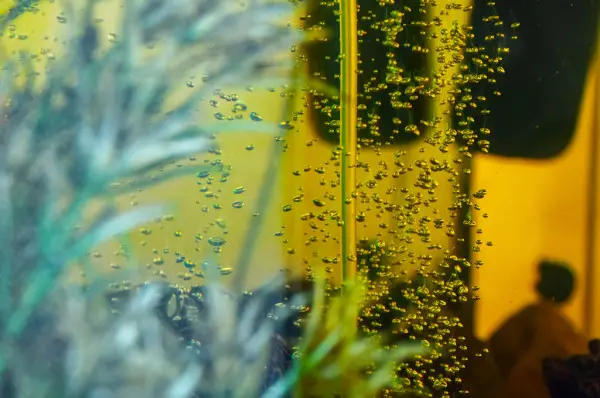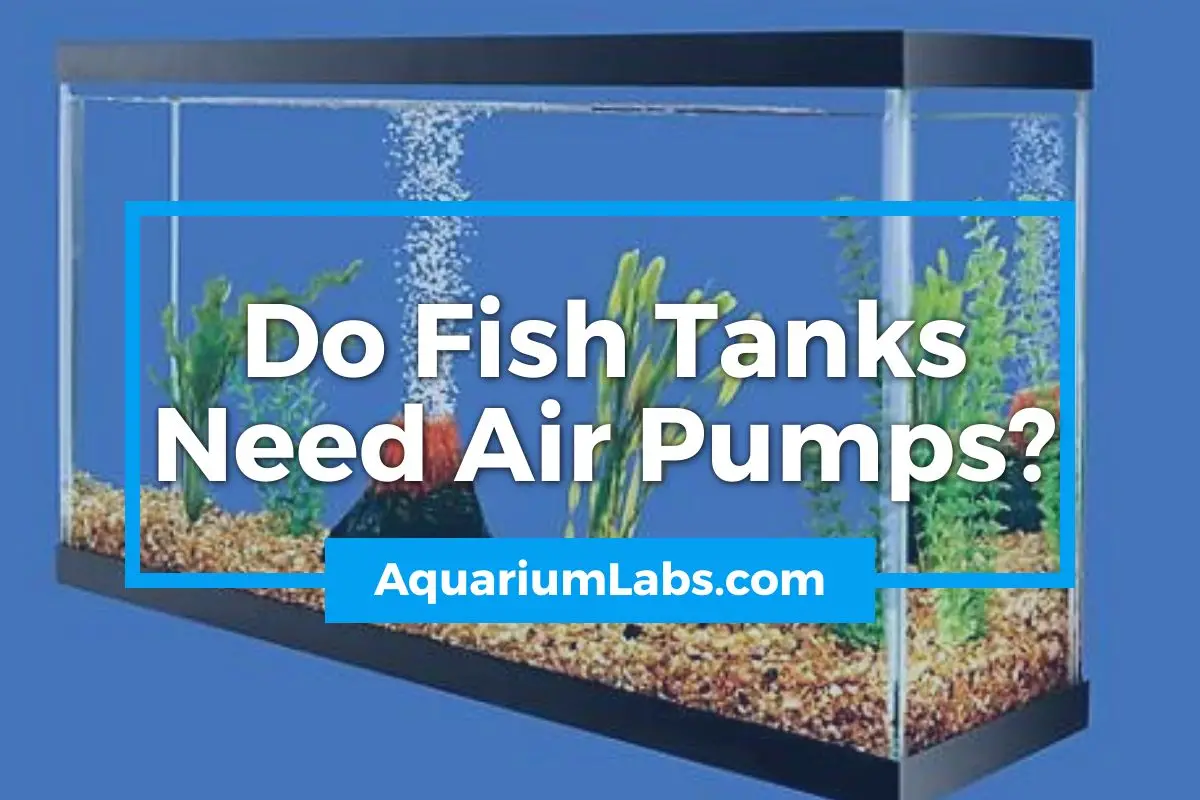An air pump is often one of the first things people think about when setting up new home aquariums. We know that equipment like lights, a filter, and a heater are pretty indispensable. But do fish tanks need air pumps or it’s no longer necessary?
It really depends on what the air pump is for and the system you have in mind. So why not first get clear on what an air pump does so you know for sure if you can go without one!
What Does An Air Pump Do?
At its core, an air pump is a very simple device! Outside of your tank is a pump that uses electricity to force air into an air tubing usually made of silicone. Air runs from the air pump into your aquarium.
But without an air stone on the other end of the air pump, you’d have just a continual stream of big, noisy bubbles. The air stone is what diffuses this constant stream of air from the pump into a fine microbubble flow. This not only quiets the resulting bubbles but also vastly improves the function of your air pump!
Because the name of the game here is creating a large surface area and improving surface agitation!
The Benefits of Surface Agitation
Surface agitation using an air stone is something that few aquarists think about when setting up a new tank. But it is a very important topic because it is the foundation for one of the most essential elements your fish and plants need: oxygen! Without ample dissolved oxygen levels, life inside your tank water simply can’t exist.
The breathable air in the atmosphere is around 21% oxygen. This concentration is roughly 100 times greater than the amount of dissolved oxygen in the water. Oxygen levels vary depending on the temperature; cooler water holds more than warm water does. But over air always holds way more oxygen than water.
Oxygen enters the aquarium environment at the surface, and carbon dioxide is released into the air at the same point. There is normally a constant gas exchange of the two molecules happening on its own. But we can speed up this process by introducing surface agitation!
When we think of an air pump, it seems like oxygen is being physically forced into the water by the pump. But what’s actually happening is that you are expanding the surface area of your tank with those bubbles.
Each bubble is an inverted surface where gas exchange can occur! In this way, you help oxygen saturate the environment faster and carbon dioxide to exist easier!
So as a general rule, we want to increase surface agitation, especially in a fish tank with a heavy population.

Aeration and Water Temperature
Another benefit to increasing surface agitation is that the stream of bubbles affects the temperature of your fish tank. Gas exchange is not the only thing lost or gained at the surface; heat is also gained or lost, depending on how warm or cold the water is relative to the air.
If you live in an area where scorching hot summers are normal, running an air pump is one of the best things you can do for your fish. Since water has a very high heat capacity, it can be very difficult to cool it down once it gets warm.
But by running an air pump, you speed up heat loss at the surface. Remember, each bubble counts as an addition to the overall surface area of the tank from the moment it leaves the air stone to breaking at the surface.
This has the net effect of cooling your aquarium in hot conditions!
An air pump with an adjustable flow, like the HITOP Powerful 110GPH Aquarium Aerator, gives you the ability to crank up the output when the weather gets uncomfortably warm!
Air Pumps for a Large Fish Tank
Using an air pump is highly recommended for deep tanks with no current from proper filtration or a powerhead. Turnover is seriously important for these tanks because, without enough water circulation, you can get dead zones in a large tank.
Areas where heat builds up are common around the heater when dealing with a larger tank size. As are regions where the water is cold because warm water isn’t flowing there. Low oxygen levels can also occur in these areas of little water movement.
Air Pumps vs Air Driven Sponge Filters
Oftentimes it is possible to kill two birds with one stone; you can raise your oxygen levels and have some filtration done at the same time! Sponge filters are a favorite of many aquarium hobbyists for this reason.
A sponge filter is essentially a plastic tube with a thick sponge on the lower end. They use air pumps as the source of power and flow, which forces air in from the top of the unit. The rising curtain of bubbles creates water movement upwards. This causes water to be sucked into the lower sponge, which acts as mechanical filter media in the process by screening out floating debris.
Sponge filters like the UPETTOOLS Aquarium Biochemical Sponge Filter also provide excellent biological filtration! All of that sponge media has loads of surface area for beneficial bacteria to colonize.
Fish waste contains ammonia and other toxic compounds. But these beneficial bacteria actually eat ammonia, transforming it into nitrite. Unfortunately, nitrite is still fairly toxic to fish – but a second set then eats it, reducing it further into nitrate. Nitrate then accumulates until you do a water change or your aquarium plants use it as fertilizer.
There are a few downsides, but not many. The main one is that you don’t get chemical filtration with most air drive sponge filters. But a few models do have small, replaceable activated carbon cartridges. The sponge is also large and very visible, taking up a lot of physical and visual real estate in your tank.
Sponge filters are only really recommended for smaller tanks – the sort of tanks where it is especially hard to hide a big sponge sitting in a corner. Though some models, like this one by UPETTOOLS, use a dual sponge design that makes them better for larger setups.
But the very gentle flow they create is perfect for dwarf shrimp, fish fry, and other sensitive pets. And you still get all of the benefits that an air pump provides in preventing low oxygen levels!
Air Pump Powered Aquarium Decorations

Fish tank decorations that take the place of air stones like this Yellow Submarine by Uxcell are another way to get excess carbon dioxide out of the water!
Fish tank decorations that take the place of air stones are another way to get excess carbon dioxide out of the water! Pretty much any local fish store will have all sorts of aquarium equipment that serves this function. Bubbling clamshells, treasure chests, and even fake fish can all serve this purpose!
Many fish tank decorations can also have a more natural appearance to them, like driftwood, rocks, or caves that have attachments for an air pump. If you need an air pump but want something that blends into the scenery better, this is a great way to replace an air stone in your fish tank!
When Should I Not Use an Air Pump?
Generally speaking, using an air pump is always a net positive. Increased oxygen levels are always a good thing, even if you aren’t keeping fish in a crowded situation. But are there times when we should not use an air pump?
Planted Aquariums with Carbon Dioxide

Planted aquascapes are like the freshwater version of a reef tank in terms of difficulty, chemical inputs, and sessile organism diversity. But adding an air pump to the tank is something you usually don’t want to do.
The problem is with the increased gas exchange that results from using air pumps. High levels of carbon dioxide are hard enough to get into the water. Fish release carbon dioxide but not at high enough levels to fuel rapid plant growth. So many aquarists that grow live plants use CO2 injection to increase saturation levels enough for plants to grow 5 to 10 times faster than they otherwise would.
But if you run air pumps in a CO2 enriched environment, you will be forcing much of it right back out into the air. The increased surface agitation from all of the air bubbles is simply a waste of carbon dioxide.
Plants add significantly to the oxygen levels anyway. And given how algae and nutrient-sensitive planted tanks are, you likely won’t have a huge fish load anyway. All reasons not to use an air pump in a planted fish tank!
Adding an Air Pump to a Fish Tank
Once you’ve decided that an aquarium air pump is right for you, where is the best place to put it inside your fish tank? Well, most aquarists prefer to place theirs near the rear of the tank. A curtain of bubbles in the middle of the aquarium or close to the front tends to be distracting.
That said, there are air stones that form a cylindrical curtain of bubbles rather than a line. These often make interesting centerpieces in an aquarium!
Can Fish Live Without an Air Pump?
What if you decide not to add an air pump to your aquarium equipment setup? Will the lack of airflow harm your fish? Fortunately, aquarium water holds plenty of oxygen on its own. So long as the tank is not overcrowded or especially deep, you should not have issues with dead spots or low oxygen levels.
A battery-powered model is one of the best aquarium air pump designs to have on hand, even if you don’t use them often. Powerful storms can sometimes knock over trees, which can take out power lines in your region.
An aquarium with no power for extended periods can sometimes suffer from oxygen deprivation if it is heavily populated and the filter provides most of your surface agitation.
A battery-powered air pump like the AQQA Aquarium Rechargeable Air Pump is an inexpensive piece of technological insurance. And it can mean the difference between your fish surviving a power outage or dying!
Wrapping Things
Air pumps are considered essential additions to the aquarium hobbyist’s tool kit for many good reasons. They boost oxygen levels while simultaneously removing excess carbon dioxide from the system. Extra water movement helps heat and oxygen get to all regions of the tank.
And in a pinch, you can combine them with sponge filters for extra mechanical and biological filtration capacity! Given how few downsides there are, I recommend adding them to the majority of aquarium setups!
Recommended Reading:

